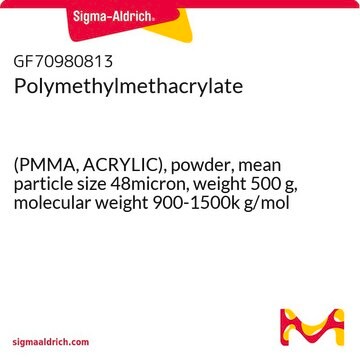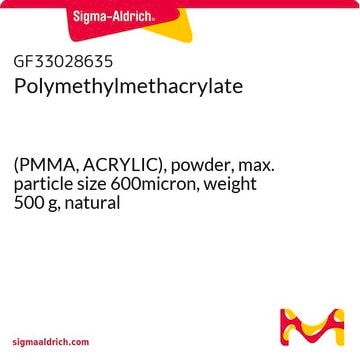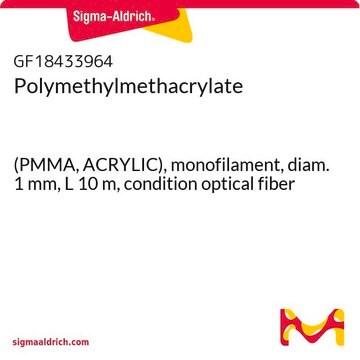If this product has an expiration or retest date, it will be shown on the Certificate of Analysis (COA, CofA). If there is no retest or expiration date listed on the product's COA, we do not have suitable stability data to determine a shelf life. For these products, the only date on the COA will be the release date; a retest, expiration, or use-by-date will not be displayed.
For all products, we recommend handling per defined conditions as printed in our product literature and website product descriptions. We recommend that products should be routinely inspected by customers to ensure they perform as expected.
For products without retest or expiration dates, our standard warranty of 1 year from the date of shipment is applicable.
For more information, please refer to the Product Dating Information document: https://www.sigmaaldrich.com/deepweb/assets/sigmaaldrich/marketing/global/documents/449/386/product-dating-information-mk.pdf
182230
Poly(methyl methacrylate)
Synonym(s):
PMMA, Poly(methacrylic acid methyl ester)
Select a Size
About This Item
Recommended Products
autoignition temp.
580 °F
Quality Level
impurities
may contain ≤2.0% toluene
refractive index
n20/D 1.49
inherent viscosity
0.20 dL/g(lit.)
transition temp
Tg (DSC) 105 °C (midpoint)
solubility
H2O: insoluble
density
1.188 g/mL at 25 °C
InChI
1S/C5H9O2/c1-4(2)5(6)7-3/h1-3H3
InChI key
PMAMJWJDBDSDHV-UHFFFAOYSA-N
Looking for similar products? Visit Product Comparison Guide
General description
Application
Some studies report its use in
PMMA-titania hybrid optical thins films[1]
PMMA/polystryrene/clay nanocomposites[3]
PMMA/polyurethane/carbon black nanocomposites for methanol fuel cells[4]
Storage Class Code
11 - Combustible Solids
WGK
WGK 2
Personal Protective Equipment
Choose from one of the most recent versions:
Certificates of Analysis (COA)
Don't see the Right Version?
If you require a particular version, you can look up a specific certificate by the Lot or Batch number.
Already Own This Product?
Find documentation for the products that you have recently purchased in the Document Library.
Customers Also Viewed
Articles
Electrospinning technique applications discussed, emphasizing control of nanofibers and assembly into 3D architectures.
Professor Aran discusses engineering graphene-based materials through careful functionalization, enabling diverse applications.
Self-healing soft electronic materials enable autonomous repair, reducing waste and costs in electronic devices.
-
How can I determine the shelf life / expiration / retest date of this product?
1 answer-
Helpful?
-
-
How is shipping temperature determined? And how is it related to the product storage temperature?
1 answer-
Products may be shipped at a different temperature than the recommended long-term storage temperature. If the product quality is sensitive to short-term exposure to conditions other than the recommended long-term storage, it will be shipped on wet or dry-ice. If the product quality is NOT affected by short-term exposure to conditions other than the recommended long-term storage, it will be shipped at ambient temperature. As shipping routes are configured for minimum transit times, shipping at ambient temperature helps control shipping costs for our customers. For more information, please refer to the Storage and Transport Conditions document: https://www.sigmaaldrich.com/deepweb/assets/sigmaaldrich/marketing/global/documents/316/622/storage-transport-conditions-mk.pdf
Helpful?
-
-
Hi, it is suitable as a cement for bone holder?
1 answer-
Unless otherwise stated, this product is intended for research use only. It is not suitable for any other purpose, which includes, but is not limited to, unauthorized commercial use, in vitro diagnostic use, or therapeutic use in humans or animals.
Helpful?
-
-
What is the Mw of Product 182230, Poly(methyl methacrylate)?
1 answer-
The molecular weight is approximately 120 kDa.
Helpful?
-
-
What is the polydispersity of Product 182230, Poly(methyl methacrylate)?
1 answer-
The polydispersity is typically between 2.0 and 2.4.
Helpful?
-
-
What is the composition of Product 182230, Poly(methyl methacrylate)?
1 answer-
The composition is approximately 6% isotactic, 39% atactic, and 55% syndiotactic
Helpful?
-
-
What is the Department of Transportation shipping information for this product?
1 answer-
Transportation information can be found in Section 14 of the product's (M)SDS.To access the shipping information for this material, use the link on the product detail page for the product.
Helpful?
-
-
What is the particle size of Product 182230, Poly(methyl methacrylate)?
1 answer-
The particle size is less than 2 mm.
Helpful?
-
-
What is Product 182230, Poly(methyl methacrylate), soluble in?
1 answer-
This product is soluble in benzene, xylene, methylene chloride, chloroform, chlorobenzene, hot cyclohexanol, dioxane, methyl ethyl ketone, acetic acid, and acetone.
Helpful?
-
Active Filters
Our team of scientists has experience in all areas of research including Life Science, Material Science, Chemical Synthesis, Chromatography, Analytical and many others.
Contact Technical Service






